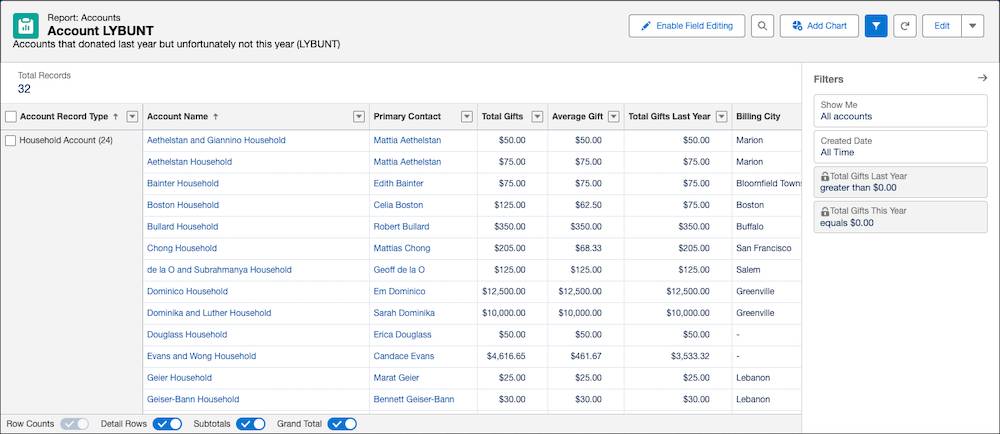Find and Run NPSP Reports
Learning Objectives
After completing this unit, you’ll be able to:
- Find and view NPSP Reports in Salesforce.
- Run a standard NPSP Report.
Meet NPSP Reports
Now that you understand how to collect and maintain your data, it’s time to put that data to work.
NPSP includes many stakeholder and fundraising reports and dashboards by default to help you get started with your data.
For example, use the reports to quickly:
- Find the contacts who donated last year, but unfortunately didn't this year, also called LYBUNT donors.
- View tasks and their assigned users that are related to engagement plans.
- Browse all accounts grouped by their highest giving year.
- Determine the donation percentage change between this year and the previous year, grouped by account.
In this unit, you follow along with the staff at the nonprofit NMH as they use NPSP reports. If you want to go further learning how to create and customize reports, check out the resources at the end of the unit.
How to Get Hands-on with NPSP
In this module, explore the steps to use reports in NPSP. There are no hands-on challenges in this module. However, if you want to practice and try out the steps, you need a special Developer Edition org that contains NPSP and our sample data. A regular Trailhead Playground doesn’t have NPSP or our sample data. Here’s how to get the free Developer Edition now.
- Sign up for a free Developer Edition org with NPSP.
- Fill out the form.
- For Email, enter an active email address.
- For Username, enter a username that looks like an email address and is unique, but it doesn't need to be a valid email account (for example,
yourname@test.com).
- For Email, enter an active email address.
- After you fill out the form, click Sign me up. A confirmation message appears.
- When you receive the activation email (this might take a few minutes), open it and click Verify Account.
- Complete your registration by setting your password and challenge question. Tip: Save your username, password, and login URL in a secure place—such as a password manager—for easy access later.
- You're logged in to your Developer Edition.
Now, you can follow along with these steps.
Browse NPSP Reports
To view all of the NPSP reports, follow these steps.
- From the App Launcher (
 ), find and select Reports.
), find and select Reports.
- Under Folders, select All Folders.
- Select a folder with a name that begins with NPSP, such as NPSP Fundraising Reports.
Use the reports to find answers to important questions. The screenshot shows reports like Accounts by Best Gift Year and Closed/Won Opportunities by Household.

To view a report, select it from the list. You can also click  for more actions, such as exporting a report, adding it to Favorites, or moving it to another folder.
for more actions, such as exporting a report, adding it to Favorites, or moving it to another folder.
View an NPSP Report
Now that you know how to find NPSP reports, follow along with the staff at NMH as they work with a report.
Like many nonprofits, NMH relies on donations from individuals and families for much of its revenue. It has a stable pool of reliable donors that it communicates with through a variety of channels, including email and direct mail.
Sofia Rivera, the NMH development associate, is responsible for keeping her team updated on the nonprofit’s fundraising progress. Sofia knows that it’s far easier to keep an existing donor than to cultivate a new one. Yet, toward the end of the year, she notices that revenue from individual and household giving is a bit under target. Why?
She decides to run a report of household accounts that donated last year but haven't yet donated this year. These donors are sometimes called Last Year, But Unfortunately Not This (LYBUNT) donors. NPSP includes a report for finding these donors easily.
Follow along with Sofia as she views the report.
- From the All Folders view in Reports, select the NPSP Fundraising Reports folder.
- Select the Account LYBUNT report.
To make sure the report is returning the correct information, click  to see how it filters the data.
to see how it filters the data.

Notice that this report returns a list of all accounts, created at any time, that gave more than $0 last year and $0 this year. This is exactly what Sofia needs!
Sofia clicks Save As to save the report with a new name. This way, she preserves the original report while experimenting with different report settings and filters. If someone else relies on the original report, this step also preserves their work.
Sofia then sends the report to her executive director and director of development for their next meeting. Together, the team decides to run a special campaign to reach out to the donors listed on the LYBUNT report. Later, they revisit Sofia’s report to segment donors by giving level and define an engagement strategy for each level of donor.
Now you know how to find and view an NPSP report. You can also use these reports as a starting point to add your own filters and find answers to specific questions at your organization. In the next unit, you learn how to customize a report with an example at NMH.
Resources
- Salesforce Help: NPSP Reporting and Analytics
- Salesforce Help: NPSP Reports Workbook
- Salesforce help: Reports and Dashboards
- Trailhead: Explore Lightning Experience Reports & Dashboards
- Salesforce Trailblazer Community Group: Salesforce.org Reports & Dashboards